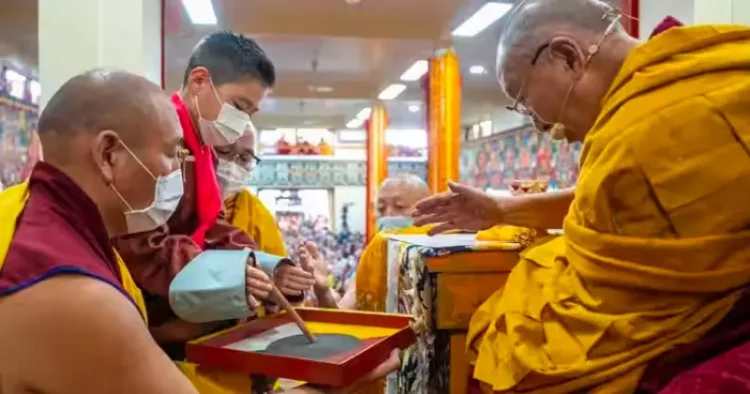On March 8, the Dalai Lama named an 8-year-old Mongolian boy the 10th Khalkha Jetsun Dhampa Rinpoche – the 3rd highest rank in Tibetan Buddhism in Dharamshala, where Dalai Lama lives in exile, India Today reported. Reportedly, the anointment ceremony was attended by about 600 Mongolians who travelled to Dharamshala for the event.
The move to name the 8-year-old boy the 3rd highest leader will reportedly irk China, as China has maintained that it would only recognise Buddhist leaders chosen by the CCP. Furthermore, the move to anoint the 8-year-old Mongolian boy as the 3rd highest leader in Buddhism has enormous ramifications in the battle between the Dalai Lama and the Chinese Communist Party (CCP) and for the survival of Tibetan Buddhism.
According to the Tibetan Press, a study by human rights experts from the United Nations on the eve of World Language Day on February 21 revealed the true nature of the CCP persecution of Tibetans, which takes the form of forcing Tibetan identity into the dominant Han Chinese identity.
A million Tibetan children were taken away from their families by the Chinese government and sent to government-run boarding schools, according to a study by UN human rights experts published on February 6, 2023, in Geneva. “We are alarmed by what appears to be a policy of forced assimilation of the Tibetan identity into the dominant Han-Chinese majority through a series of oppressive actions against Tibetan educational, religious, and linguistic institutions,” the experts say in their report.
The Chinese rulers in Tibet used the residential schooling system as a ploy to assimilate Tibetan people culturally, religiously and linguistically with the Han identity.
“We are very disturbed that in recent years the residential school system for Tibetan children appears to act as a mandatory large-scale programme intended to assimilate Tibetans into majority Han culture, contrary to international human rights standards,” the experts have said in a statement.
In these residential schools, the educational content and the environment are built around the majority Han culture, with contexts in textbooks reflecting almost solely the experiences Han students face in the course of their lives. Tibetan children are forced to complete a “compulsory education curriculum” in Mandarin Chinese (Putonghua, standard Chinese) without access to learning relevant Tibetan traditions and culture.
As a consequence of these schools’ lack of studies in Tibetan language, history, and culture, Tibetan students are losing proficiency in their language and the capacity to converse freely with their parents and grandparents in Tibetan, leading to their assimilation with the Han Chinese identity and the erosion of their own identity.
The experts’ report indicates that promoting these residential schools in Tibet is part of a Chinese conspiracy to destroy Tibetan identity and culture. Such residential schools have mushroomed in and outside the Tibet Autonomous Region, with the large majority of Tibetan children studying there, and their number is increasing.
At the national level in China, the share of students studying in boarding schools is much lower in percentage. Since they believe it is the only way Tibetans can be weaned away from their intense belief in Buddhism, China’s communist rulers are eager to destroy Tibetan culture, language, and way of life. For the intolerant rulers of China, religious belief is like a red rag to a bull, the Tibetan Press reported.
Buddhism is inseparable from the Tibetan language, culture and way of life. Buddhism influences the Tibetan way of life from the moment of birth till the moment of death. When a child is born, his parents rejoice by giving food to the needy and offering to Lord Buddha and the monks. Lamas are invited to perform religious services in houses where a child is born. The family’s second child is usually sent to the monastery to become a monk.
When the Chinese army invaded Tibet in 1950, they found Buddhism to be the force unifying all Tibetans, and the Dalai Lama symbolised this unity. The Chinese rulers systematically dismantled the Buddhist religion by targeting the monks. A large number of monasteries in Tibet were destroyed. The Dalai Lama fled to India in 1959, along with a large number of Tibetans. Till recently, about 150 monks in Tibet have courted death by self-immolation in protest against the attack on their religion, the Tibetan Press reported.
Scholars have noted the Chinese contempt for non-Chinese culture. To the Chinese government, Tibetan Buddhism is a threat to its rule and a challenge to its goal of colonising Tibet, writes the website of Free Tibet, an organisation of Tibetan refugees. The Chinese government’s strategy for suppressing Tibetan opposition to its rule centres on undermining and eradicating the special practises of Tibetan Buddhism. As a result, Tibetan Buddhism is exposed to invasive state interference in every aspect.
Having failed to wean the Tibetan people away from the Buddhist faith after more than 70 years of illegal occupation of Tibet, mandarins of the CPC have floated the idea of Buddhism with Chinese characteristics. The real intention behind this idea is to interfere in choosing the next Dalai Lama and foist on the Tibetan people a Dalai Lama of their own choice.
(With inputs from ANI)



















Comments